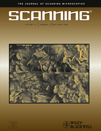Mistakes encountered during automatic peak identification of minor and trace constituents in electron-excited energy dispersive X-ray microanalysis†
This article is a US government work and, as such, is in the public domain in the United States of America.
Abstract
Automated peak identification in electron beam-excited X-ray microanalysis with energy dispersive X-ray spectrometry has been shown to be subject to occasional mistakes even on well-separated, high-intensity peaks arising from major constituents (arbitrarily defined as a concentration, C, which exceeds a mass fraction of 0.1). The peak identification problem becomes even more problematic for constituents present at minor (0.01≤C≤0.1) and trace (C<0.01) levels. “Problem elements” subject to misidentification as major constituents are even more vulnerable to misidentification when present at low concentrations in the minor and trace ranges. Additional misidentifications attributed to trace elements include minor X-ray family members associated with major constituents but not assigned properly, escape and coincidence peaks associated with major constituents, and false peaks owing to chance groupings of counts in spectra with poor counting statistics. A strategy for robust identification of minor and trace elements can be based on application of automatic peak identification with careful inspection of the results followed by multiple linear least-squares peak fitting with complete peak references to systematically remove each identified major element from the spectrum before attempting to assign remaining peaks to minor and trace constituents. SCANNING 31: 91–101, 2009. Published by Wiley Periodicals, Inc.




